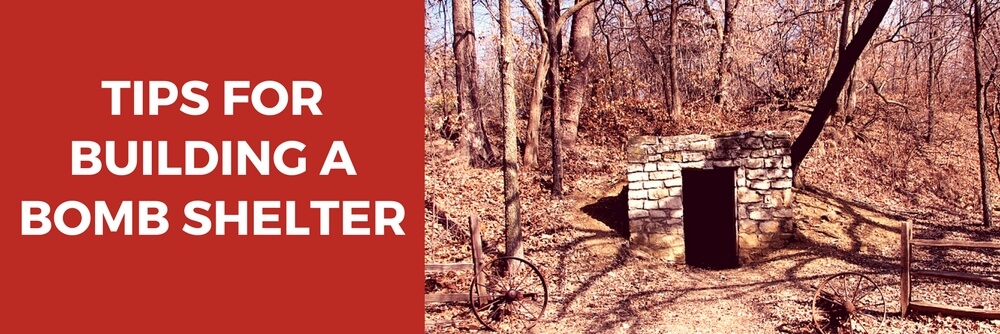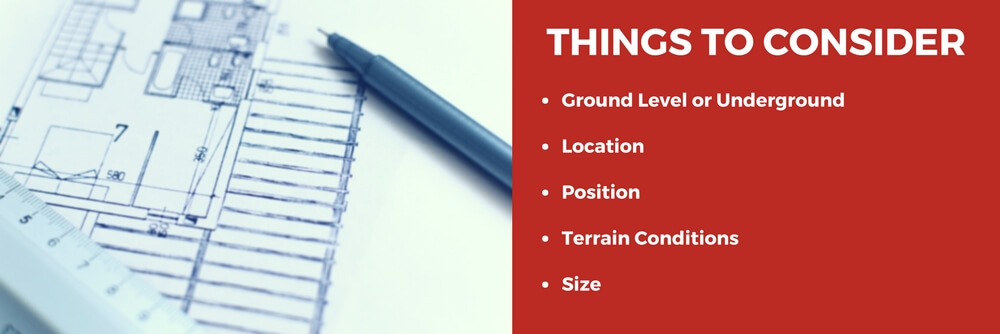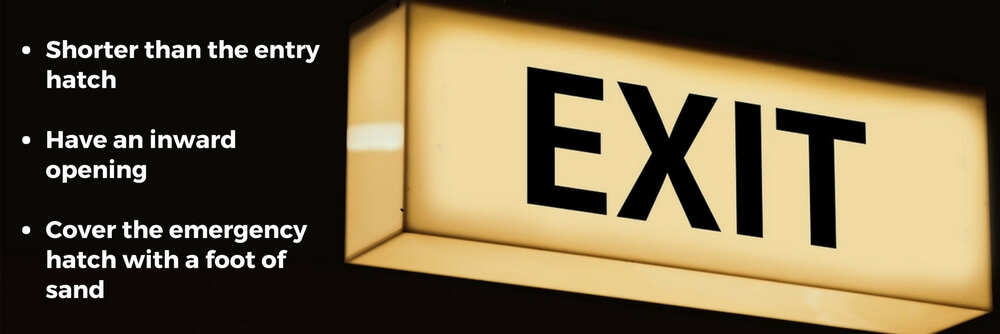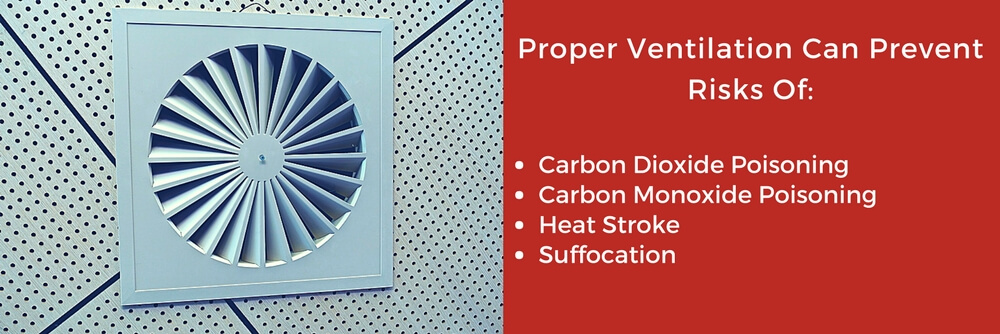TIPS FOR BUILDING A BOMB SHELTER
In a world of technological advancement, nuclear weaponry and dynamic political climates, it would be impossible to predict every disaster that could strike at any moment. While unlikely, a nuclear attack is one of the worst scenarios that families tend to envision — and they immediately wonder how they would handle such a devastating turn of events.
Many of these thinkers choose to be proactive about their worries and build a bomb shelter not because they’ve given in to fearmongering or become obsessed with doomsday, but because they know being prepared “just in case” is never a bad idea. Bomb shelters or underground bunkers can protect against more than just bomb detonations — they can save lives during biological and chemical attacks, nuclear meltdowns and other emergency situations.
If you’ve decided you want a structure of your own for your peace of mind, you have many decisions ahead of you. Many families decide to hire bomb shelter contractors to do the work for them, rather than to buy a bomb shelter.
Here at R.J. Potteiger Construction Services, Inc., we’ve completed a few bomb shelter construction projects of our own, so we’ve compiled some bomb shelter tips to help you get the job done right.
SITE PREP BEFORE THE CONSTRUCTION
Once you make the decision that you’d feel safer having a bomb shelter on your property, it’s time to start preparing the site. You’ll need to nail down several details during this stage of bomb shelter planning to ensure you’re happy with the final product and that it’s entirely safe. Without proper site preparations, the shelter could end up more dangerous on its own than any threats you’re trying to protect against.
Prior to construction, you’ll want to carefully consider factors like:
- Ground Level
- Location
- Position
- Conditions
- Size
BUILDING A SHELTER GROUND LEVEL OR ABOVE GROUND
The process for building a fallout shelter belowground involves significantly different steps than building one aboveground. The amount of matter between you and the outside world affects how protected you are, which makes the soil packed around your bomb shelter material in belowground structures valuable. Thicker layers in the shelter help to protect inhabitants against the blast itself as well as the resulting radiation. Building belowground also hides the shelter from neighbors and passersby.
LOCATION: WHERE TO BUILD YOUR BOMB SHELTER
Once you’ve decided whether you want your bomb shelter above or below ground, choose exactly where to place it for quick and convenient access. It needs to be near enough to your home for you and your family to get inside quickly, as shelters too far away are rarely helpful in an unexpected emergency. If you want to avoid people around your home knowing about your construction for any reason, you might have to choose a specific location or get creative to hide the building process.
WHERE TO POSITION YOUR BOMB SHELTER
If you have a solid idea where a bomb blast might come from during an attack, you can position your bomb shelter so it has more layers between itself and that location. For instance, if you live near a major airport, you could build your shelter into or on the other side of a hill so that the mass of the land protects you even more thoroughly from the blast and fallout. Areas usually considered high-risk are capitals, transportation and communication centers, chemical plants, military bases and similar areas.
HOW ARE THE TERRAIN CONDITIONS WHERE YOU WANT TO BUILD YOUR SHELTER?
Before making a final judgment about your site, carefully consider the terrain where you picture the shelter. You need to know its water levels throughout the entire year to make sure a deep freeze in the soil doesn’t cause underground shelter walls to crack. You must be willing to pump water out of a hole with a high water table to keep the shelter from floating or water seeping in. This also allows concrete bomb shelters to set properly.
HOW BIG DO YOU WANT YOUR BOMB SHELTER TO BE?
You should consider how “luxurious” you want your bomb shelter to be, as you might find yourself in it for a long stretch of time. This depends on how much money, effort and time you’re willing and able to put into construction. Whether you choose to design it with many of the same areas as a small home or keep it at its most basic, you’ll have to factor in enough space for the number of people you expect to house. Many models allow enough room for four people to fit inside safely.
Once you’ve found an area with enough space for your bunker and determined it’s the location you want, it’s time to start preparing the site. Begin by staking and cordoning-off a measured area where bomb shelter construction will take place. From conception to the finishing touches, the work could easily take several days or longer, even with the help of friends and family.
You don’t want people wandering into or near your building site during off-hours when you’re not nearby, as large holes and other parts of the structure could be extremely dangerous.
BOMB SHELTER CONSTRUCTION
The first thing you need to decide before the building process begins is what bomb shelter materials you plan to use as its primary components. Bomb shelter builders throughout the decades have used countless elements like lead, steel, wood, packed soil or a combination of several.
One of the most popular and effective materials is concrete because it offers solid protection against blast and fallout concerns and allows for a sturdy foundation that won’t cave in. It can also be purchased at a realistic and affordable price, which helps make the case for concrete.
The following are six stages of successfully building your own bomb shelter:
- Decide on the design.
- List the tools and materials you’ll need for the job.
- Dig a trench for an underground shelter.
- Build emergency exits.
- Construct air vents.
1. DECIDE ON DESIGN FOR YOUR BOMB SHELTER
No matter what size you decide to make your bomb shelter in the planning phase, you need to implement several elements for optimal safety and livability. After all, a structure designed to house several people for an unpredictable number of days has to be more than a reinforced hole in the ground. You’ll need to plan for emergency exits, ventilation and other primary components of the shelter that will require construction consideration.
A space of about twenty square feet for each person inside the shelter is sufficient for everyone to complete basic life tasks like eating, sleeping and storing some supplies. Be sure you have accurate measurements for the entire area inside your bomb shelter and around its perimeter. Once you start filling in the concrete, it will be difficult to make extensive changes. Precise designs and measurements from the beginning will allow you to avoid major issues in the process.
Create blueprints while outlining the interior of your bomb shelter with special attention for a bathroom, eating space and food storage. You’ll have several options for waste disposal when you start stocking the shelter, but no matter what you choose it’s critical to keep food and human waste as far away from one another as possible. A spread of bacteria or infection throughout the shelter or in your food supplies could easily lead to fatal illnesses or starvation before you’re able to safely exit the structure.
2. LIST THE TOOLS AND MATERIALS TO BUILD YOUR BOMB SHELTER
Now that you’ve chosen your design and planned for building, you should know exactly what tools you need for the job. Stopping and starting throughout the process for tools you didn’t bring can seriously delay production, so a little foresight helps. You may need shovels, picks, hammers, gravel, steel bars, sand, wood planks, cement and other materials. Gather as much in the beginning as possible.
If you’ve decided that you want to go with one of the most reliable materials for your bomb shelter, you’ve probably chosen concrete — you just need a supplier. We can help with any concrete projects and we work with our clients one-on-one to personalize the experience. No matter how unique or customized your bomb shelter or other concrete construction project happens to be, you can trust our company for construction services.
3. DIG A TRENCH FOR AN UNDERGROUND SHELTER
It’s a good idea to complete a soil test to determine holding capacity before you start digging for underground bomb shelter construction. The test ensures the soil won’t cave in and injure anybody once underground bunker work has begun. As soon as you know the ground is safe to work on, you can start digging your hole based on the size and design you’ve chosen for your shelter. Remember that the interior of the hole needs to be a little larger than that of the finished building.
How deep you nestle the structure into the ground is up to you, but keep in mind that the more space and layers you put between you and the hazards, the more protected you will be. Many builders decide to dig far into the ground so they can pair layers of packed earth with several inches or even feet of concrete. Experienced bomb shelter builders often recommend at least three feet of earth between the main portion of the shelter and the open air.
When considering the way radiation functions, it helps to think about radiation as heat you can’t sense in any way. You’re far less likely to be burned if you stay far away or have a lot between you and the heat source. One major difference is that radiation can’t make turns. Include 90-degree turns in air ducts and doorways to ensure it doesn’t get inside your structure.
4. BEGIN MASONRY OR CONCRETE WORK FOR YOUR BOMB SHELTER
Though not the most highly-recommended option for several reasons, if you decide to build your bomb shelter aboveground, you can bypass most digging and go straight to erecting your concrete bomb shelter. In this case, use a minimum of two feet of concrete for the walls and a dome masonry roof to protect against nuclear radiation and radiation exposure.
If you’ve opted to build an underground version of a concrete bomb shelter, you can start building your walls against the packed earth. It’s important to use proper support for the material before working with it, and especially before building structures above your head.
If you’re looking for information about staying safe with concrete applications or you need help with your next project, call us at (717)-697-3192. We’re always glad to help, give you answers and provide you with the services you need.
5. BUILD EMERGENCY EXITS
In addition to the main entrance, you should always include an emergency hatch at the back end of any fallout shelter. It should be shorter than the entry hatch so that people can leave quickly in the event of an emergency like fire. Any number of external forces could compromise the main hatch, which would leave inhabitants in serious trouble if they don’t have an emergency exit.
It’s suggested that you build your emergency hatch with an inward opening. It should go to the surface of the ground with about a foot of sand above it. The sand would fall into the shelter if anybody pulled the hatch open, which would allow residents to leave.
6. CONSTRUCT AIR VENTS
Neglecting this step would quickly result in disaster. Sealing several individuals inside a small space underground would lead the interior to become unbearably hot. The human body produces natural water vapor. Without ventilation in the shelter, everyone trapped inside would be at risk for carbon dioxide or carbon monoxide poisoning, heat stroke or suffocation. In emergency circumstances, exiting the bomb shelter could be fatal. Build the right ventilation to keep everyone safely inside.
First off, you need air-intake and exhaust pipes at opposite ends of the shelter to facilitate the flow of air. During warm weather, air can stay stagnant even with vents. Consider an air pump that you can operate manually to remove stale air from the structure and pull in fresh air from outside. The Kearney air pump (KAP) is a popular option that’s easy to build at home in just a few hours, even for beginners.
While less crucial than ventilation, air filtration is a smart decision if you want to have the most functional bomb shelter possible. Some people believe having 90-degree angles throughout the entrances and ventilation systems is enough, but adding air filtration is an additional layer of assurance that radioactive particles are safely out of the shelter. You’ll want nothing but fresh air moved into the shelter, and an air filtration system allows it.
PROVISIONS FOR DISASTER
When considering a nuclear disaster, you’ll need to plan for more than just a few cans of soup to feed you and your family. In the event that you need to stay in the bomb shelter for several days or longer before safe evacuation becomes possible, you won’t want to run out of essential supplies like food, water and basic first aid materials. Stock the shelter well in advance so that an unexpected catastrophe doesn’t leave you unprepared in an empty shelter.
Different courses of action for stocking your shelter depend on how long you anticipate staying inside. It’s helpful to think about a few possible timeframes like 72 hours, two weeks or even three months. Obviously, the longer time period you plan and stock for, the less you have to worry about rationing supplies if you get trapped inside. Some specific items you won’t want to forget before heading into your shelter include:
- Water: Avoiding dehydration should be the top priority, which means you’ll want to stock large containers of water. Bypass small bottles to save space and reduce waste.
- Food: Any nonperishables are fine for your bomb shelter, but if there’s any risk of the area becoming damp over time, consider reducing or eliminating paper and cardboard. In addition, choose items that will keep waste to a minimum.
- Sleeping arrangements: While you could use blankets or clothing on the ground as beds if you plan far enough in advance, you can construct bunk beds for more comfort instead. Fold-down bunk beds would allow seating space for your family when no one is sleeping.
- Storage: If you’ve opted into the bunk bed option for your sleeping arrangements, you’ll be able to store five-gallon containers of water or other materials under them. You might also consider personal lockers or cabinets for each individual. Simple shelving is fine for food, but consider plastic sheeting so you can avoid fallout particles on your food.
- Waste disposal: For waste like containers from food products, a regular trash bag will be fine. However, human waste needs to be disposed of properly without electricity. A few options exist, but five-gallon buckets lined with heavy trash bags work fine to keep it simple. As long as the buckets have securely-sealed lids and are disposed of near air exhaust, they’re a good option. Some families include cat litter to cover waste in layers.
- Miscellaneous: Be sure to pack clothing, a first-aid kit and possibly pest control. Leading authorities on the topic of bomb shelter design also suggest communication radios if you can manage it.
- Extra items: We’ve pretty much covered the supply essentials already, but you can bring anything else you might want that won’t be a hazard or take up too much space. For instance, some people pack books or other entertainment choices.
WANT TO WORK WITH AN EXPERIENCED BOMB SHELTER CONSTRUCTION COMPANY?
Constructing a bomb shelter is not something to take lightly. After all, a secure, well-built shelter could be responsible for saving you and your family’s lives in a disaster. If you have specific needs or goals, finding the right bomb shelter contractors ensures you are able to meet them.
At R.J. Potteiger Construction Services, Inc., we follow a team-based approach. No matter the size or scope of your project, our bomb shelter contractors will take the time to learn about your expected project outcomes and then work one-on-one with you to achieve them.
We are a fully licensed, insured and bonded company, so you can feel confident in our commitment to quality, pricing and workplace safety — no matter what kind of concrete bomb shelter we’re building for you.
LEARN MORE ABOUT OUR CONSTRUCTION SERVICES FOR YOUR BOMB SHELTER NEEDS
If you’ve started planning for your bomb shelter construction, it’s time to gather materials and get to work. If you want help with building a concrete bomb shelter, R. J. Potteiger Construction Services, Inc. can assist! We’re always attentive to our customers’ unique needs and we’ve been helping our clients with concrete and construction goals for more than 20 years throughout central Pennsylvania and the surrounding area.
To learn more about our concrete construction capabilities, visit our concrete services page!
Contact us today or call our office at (717) 697-3192 if you want to get started on your concrete bomb shelter construction right away!








